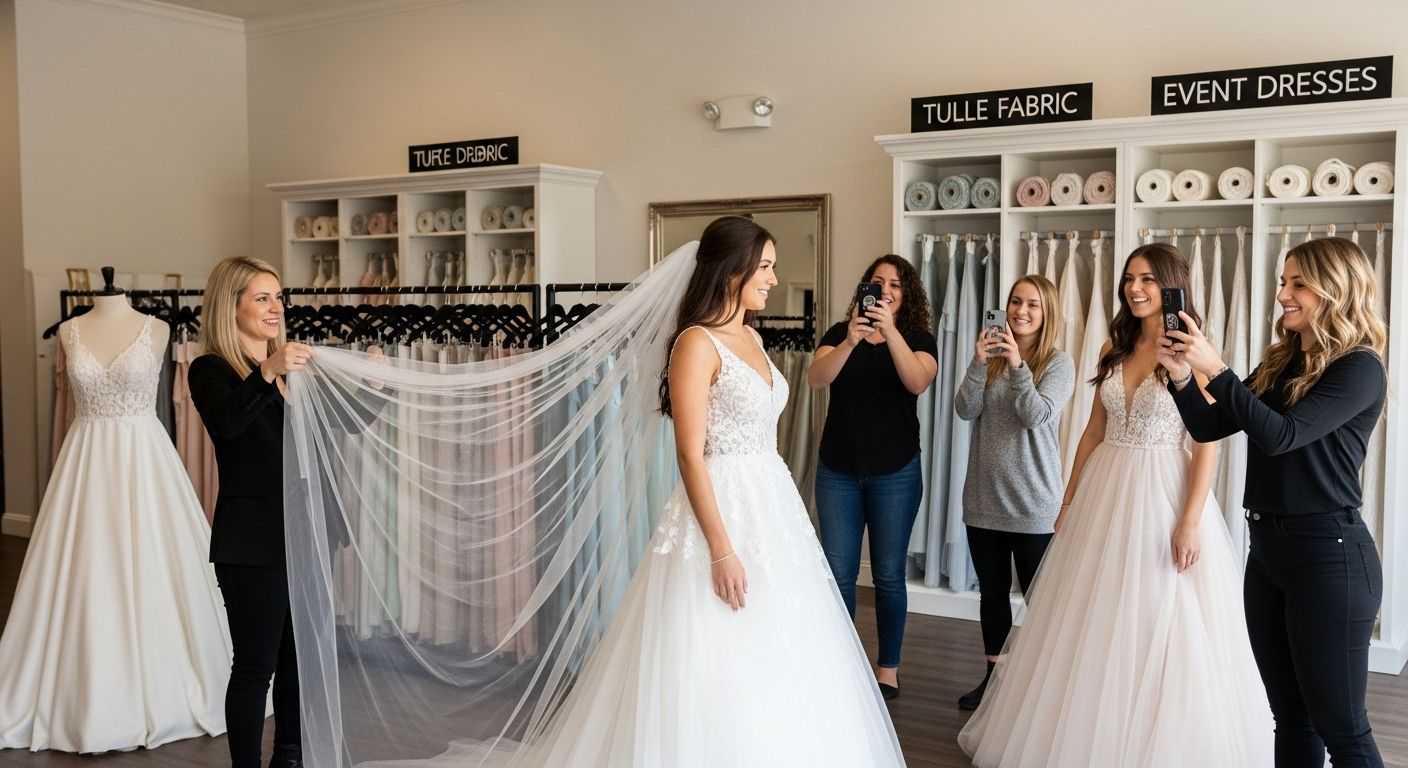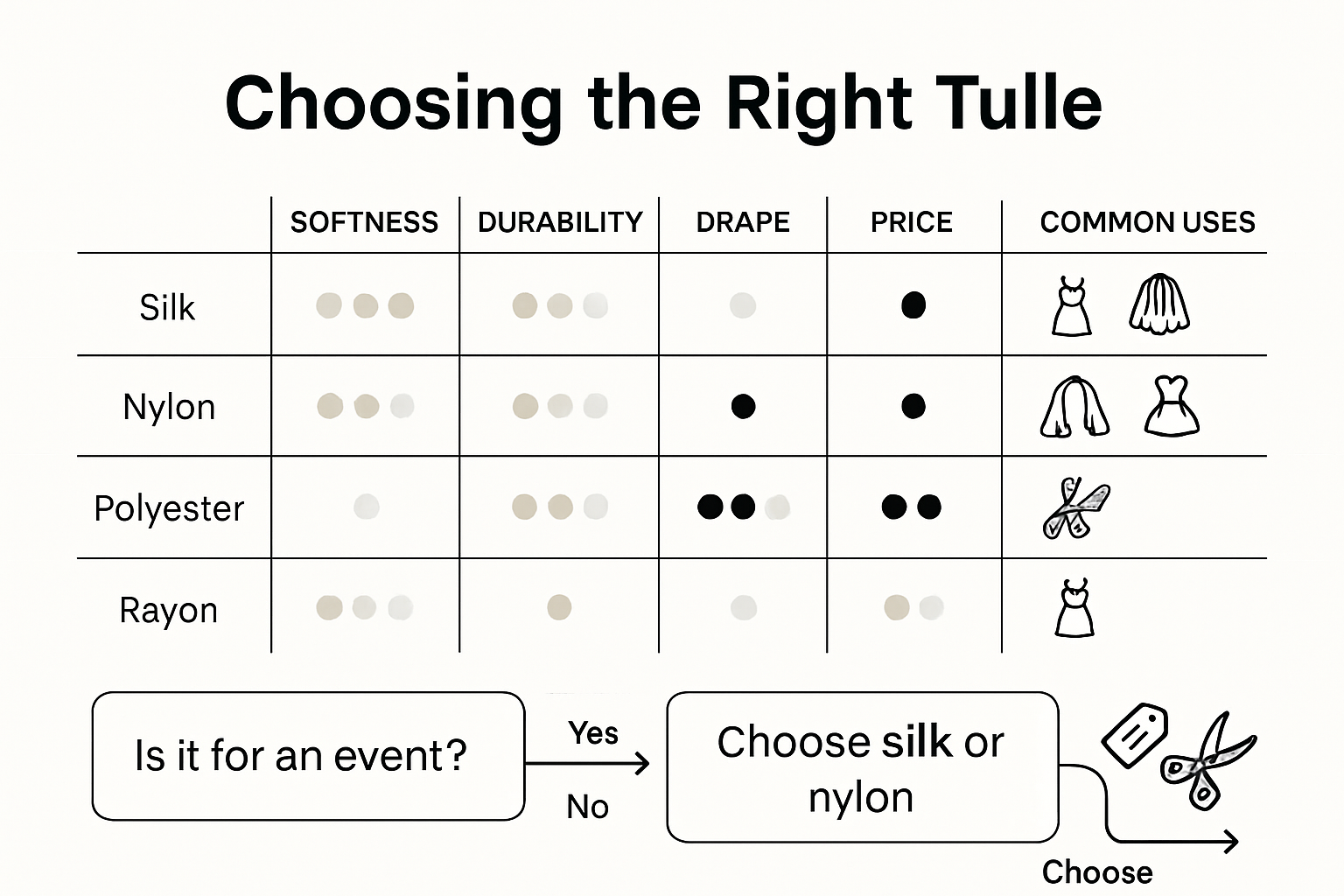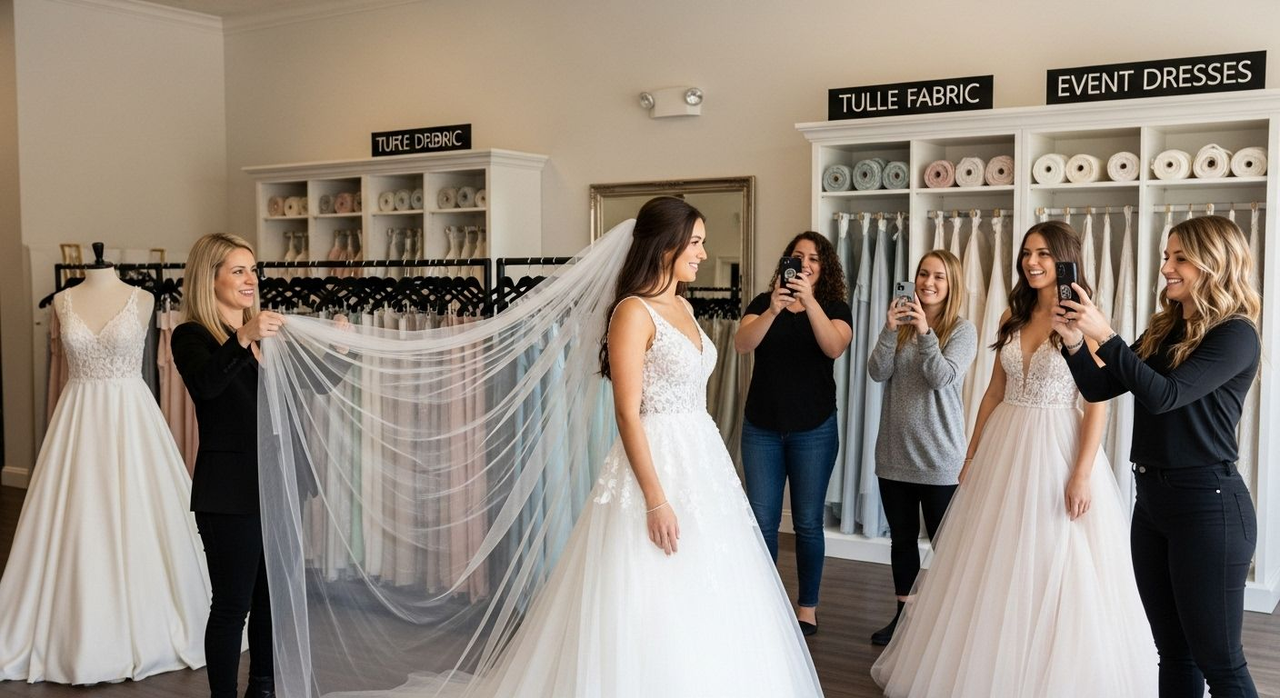What Is Tulle Fabric? Guide for Prom, Wedding, and Event Dresses
What Is Tulle Fabric? Guide for Prom, Wedding, and Event Dresses

Tulle fabric shows up everywhere from dreamy wedding gowns to unforgettable prom nights and even Broadway stages. Most people only see it as a soft, fluffy netting spun into ballerina skirts or bridal veils. But tulle holds a hidden story few know about. It was once so rare that only aristocrats in 19th-century France could afford silk tulle gowns, and now over 80 percent of modern tulle is made from durable synthetics. The real surprise is how this delicate fabric manages to look weightless and romantic while secretly holding more structure than you’d expect—ready to reshape everything you thought about formalwear and event fashion.
Table of Contents
- What Is Tulle Fabric and Its Origins
- Key Characteristics of Tulle Fabric
- Popular Uses for Tulle in Formalwear
- Tips for Choosing Tulle Dresses for Events
Quick Summary
| Takeaway | Explanation |
|---|---|
| Tulle is a versatile fabric. | Used in various designs, tulle adds elegance and structure to formal and everyday wear alike. |
| Choose fabric composition wisely. | Opt for silk tulle for luxury or synthetic options for durability and affordability based on event needs. |
| Understand your body type. | Selecting a tulle dress that complements your shape enhances your appearance and boosts confidence. |
| Consider event appropriateness in styles. | Match the dress style and length to the event’s formality to ensure suitable attire. |
| Accessorize minimally for tulle. | Since tulle is visually complex, keep accessories simple to not detract from the dress’s elegance. |
What Is Tulle Fabric and Its Origins
Tulle fabric represents a delicate and versatile textile that has transformed fashion and design across multiple industries. From wedding gowns to ballet costumes, this lightweight netting material offers a unique blend of elegance and structural complexity that makes it a favorite among designers and fashion enthusiasts.
The Technical Definition of Tulle
At its core, tulle is a fine, lightweight net-like fabric characterized by its distinctive hexagonal mesh structure. According to the Textile Glossary, tulle is typically crafted from various fibers including silk, rayon, nylon, or polyester using a specialized weaving technique called ‘bobbinet’. This intricate manufacturing process creates the signature transparent and airy quality that makes tulle so unique.
The fabric’s lightweight nature allows it to be simultaneously delicate and structured. Its transparent appearance enables designers to create voluminous layers and dramatic silhouettes without adding significant weight to a garment. This characteristic makes tulle particularly popular in formal wear, where creating visual drama and elegance is crucial.
Historical Origins of Tulle
The Museum of Fine Arts research reveals that tulle originated in the 19th century, emerging as a revolutionary textile technique. Named after the French city of Tulle, where the fabric was first produced, this material quickly became synonymous with luxury and sophistication. Initially created using silk, tulle was an expensive and highly prized fabric reserved for aristocratic and upper-class fashion.
The industrial revolution played a significant role in democratizing tulle production. As manufacturing techniques advanced, the fabric became more accessible, transitioning from an exclusive luxury item to a versatile material used across various fashion and design applications. Technological innovations allowed manufacturers to produce tulle using synthetic fibers like nylon and polyester, making it more affordable and widely available.
Modern Applications of Tulle
Today, tulle has transcended its historical origins to become a multi-purpose fabric. While it remains a staple in formal wear such as wedding dresses, prom gowns, and ballet costumes, designers have found increasingly creative applications. Contemporary fashion has seen tulle used in everything from avant-garde runway pieces to everyday clothing items like skirts, overlays, and decorative elements.
The fabric’s ability to add volume, create ethereal layers, and provide structural support makes it invaluable in costume design, performance wear, and high fashion. Its versatility extends beyond clothing into areas like event decoration, where it is used to create dramatic backdrops, table runners, and intricate design elements that add a touch of romance and sophistication to special occasions.
Understanding tulle is about appreciating its complex history, technical construction, and remarkable adaptability. From its origins in 19th-century France to its current status as a global fashion staple, tulle continues to inspire designers and captivate audiences with its unique blend of delicacy and structural integrity.
Key Characteristics of Tulle Fabric
Tulle fabric distinguishes itself through a remarkable set of physical and aesthetic properties that make it a unique textile in the fashion and design world. Understanding these key characteristics helps designers and consumers appreciate the fabric’s versatility and potential for creating stunning visual effects.
Structural Composition and Texture
The Textile Museum research reveals that tulle is an open-weave, fine net fabric characterized by its exceptional lightweight and transparent qualities. The fabric’s structure is defined by its intricate hexagonal mesh pattern, which creates a delicate yet resilient material that can hold complex shapes while maintaining an ethereal appearance.
The texture of tulle is simultaneously soft and crisp, providing designers with a unique medium for creating volume and movement. Its fine netting allows light to pass through, creating a luminous effect that can range from subtle shimmer to dramatic transparency. This characteristic makes tulle particularly effective for layering, where multiple sheets can create depth and visual complexity without adding significant weight to a garment.
Fabric Varieties and Fiber Composition
Tulle comes in a wide range of fiber compositions, each offering distinct properties and aesthetic qualities. Traditional silk tulle represents the most luxurious variant, prized for its exceptional softness and natural sheen. Modern synthetic alternatives like nylon and polyester tulle provide increased durability, easier maintenance, and more affordable pricing points.
The fiber composition significantly impacts the fabric’s performance. Silk tulle tends to be more delicate and requires careful handling, while synthetic versions offer greater resistance to wrinkling and easier care. Some contemporary tulle fabrics blend multiple fibers to achieve optimal characteristics, combining the luxurious feel of natural fibers with the practicality of synthetic materials.
To help you quickly understand the differences between tulle fabric types, here is a comparison table summarizing their key features, advantages, and common uses as described in the article.
| Type of Tulle | Material/Fiber | Key Features | Advantages | Common Uses |
|---|---|---|---|---|
| Silk Tulle | Silk | Very soft, natural sheen | Luxurious, elegant | High-end gowns, bridal wear |
| Nylon Tulle | Nylon (synthetic) | Durable, can be stiff or soft | Affordable, resilient | Everyday wear, decorations, veils |
| Polyester Tulle | Polyester (synthetic) | Durable, holds shape well | Easy care, affordable | Event decor, performance costumes |
| Rayon Tulle | Rayon (synthetic) | Soft with subtle sheen | Lightweight, affordable | Overlays, dress accents |
| Blended Tulle | Mix of fibers | May combine softness and durability | Balanced feel/performance | Fashion, costumes, unique designs |

Performance and Design Capabilities
Tulle’s most remarkable characteristic is its ability to create dramatic visual effects with minimal material. The fabric’s inherent structure allows it to maintain volume and shape, making it ideal for creating architectural and sculptural designs in fashion and costume. Its lightweight nature enables designers to build complex silhouettes that appear almost weightless, from voluminous ball gowns to delicate ballet costumes.
The fabric’s versatility extends beyond clothing. Tulle can be stiffened or softened through various treatments, allowing designers to manipulate its structural properties. This adaptability makes it useful in everything from haute couture fashion to theatrical costumes, wedding veils, and even architectural and interior design applications.
Understanding tulle’s key characteristics reveals why it remains a beloved fabric among designers and fashion enthusiasts. Its unique combination of transparency, structural integrity, and aesthetic potential continues to inspire creative applications across multiple industries, proving that this delicate fabric is far more than just a simple netting material.
Popular Uses for Tulle in Formalwear
Tulle fabric has become an indispensable material in the world of formalwear, transforming how designers create elegant and dramatic garments across multiple occasions. Its unique properties make it a go-to textile for creating breathtaking designs that capture attention and imagination.
Bridal and Wedding Attire
According to SewGuide, tulle plays a pivotal role in wedding fashion, particularly in creating stunning bridal wear. Wedding gowns frequently incorporate tulle to generate volume, structure, and an ethereal quality that defines romantic bridal aesthetics. Designers use multiple layers of tulle to craft voluminous skirts, delicate veils, and intricate overlays that add depth and movement to wedding dresses.
The fabric’s ability to create dramatic silhouettes without adding significant weight makes it perfect for brides seeking both elegance and comfort. From classic ball gowns to modern minimalist designs, tulle provides designers with incredible flexibility in creating unique wedding attire. Our collection of wedding dresses showcases the versatility of tulle in contemporary bridal fashion.
Performance and Event Costumes
Wikipedia notes the fabric’s longstanding connection to performance costumes, particularly in ballet and theatrical productions. Ballet tutus represent the most iconic example of tulle’s transformative potential. Dancers rely on tulle’s ability to create structured yet lightweight garments that allow maximum movement while maintaining visual drama.
Beyond dance, tulle has become essential in creating costumes for theatrical productions, music performances, and high-fashion runway shows. Its capacity to be stiffened or softened allows costume designers to achieve precise structural effects, from rigid geometric shapes to flowing, ethereal designs. The American Academy of Fashion Design highlights how contemporary designers manipulate tulle to create architectural garments that challenge traditional costume design.
Formal and Evening Wear
Tulle has revolutionized formal and evening wear by offering designers a fabric that can create stunning visual effects with minimal material. Prom dresses, cocktail gowns, and red carpet ensembles frequently incorporate tulle to generate volume, create intricate layering, and add a sense of luxury and sophistication.
The fabric’s versatility allows for multiple design approaches. Designers can use tulle as a delicate overlay to add shimmer and depth to solid-colored gowns, or create entire dresses composed of carefully structured tulle layers. Its ability to catch and reflect light makes it particularly effective for evening wear, where creating visual drama is paramount.
From wedding ceremonies to dance performances, from red carpet events to avant-garde fashion shows, tulle continues to be a transformative fabric that pushes the boundaries of design. Its unique combination of structural integrity, lightness, and aesthetic potential ensures that tulle will remain a crucial material in formalwear for years to come.
Tips for Choosing Tulle Dresses for Events
Selecting the perfect tulle dress requires careful consideration of various factors to ensure you look stunning and feel confident at your special event. Understanding how to choose the right tulle dress can transform your appearance and create a memorable fashion moment.
Understanding Fabric Composition and Quality
According to Tissura, tulle is a lightweight mesh fabric originally made from silk but now produced from diverse fibers like cotton, nylon, rayon, and acetate. When choosing a tulle dress, examining the fabric’s composition is crucial. SewGuide emphasizes that the fabric’s material significantly impacts its drape, durability, and overall aesthetic.
Synthetic tulle tends to be more affordable and easier to maintain, making it ideal for more casual events. Silk tulle offers a luxurious feel and superior drape, perfect for high-end formal occasions like weddings or galas. Consider the event’s formality and your personal comfort when selecting the tulle composition. Breathability and weight are also essential factors to ensure you remain comfortable throughout the event.
Selecting the Right Dress Style for Your Body Type
Tulle’s unique ability to create volume means selecting a dress that complements your body shape is paramount. Our designer dress collection offers various silhouettes that can accentuate your best features. For petite frames, A-line tulle dresses with moderate volume can create the illusion of height without overwhelming your figure. Tall individuals can experiment with more dramatic, full-volume tulle skirts that showcase their statuesque proportions.
Pear-shaped bodies might benefit from tulle dresses with structured bodices that draw attention upward, while apple-shaped figures can opt for empire waist designs that provide definition and flow. Pay attention to the dress’s layering and how the tulle is structured to ensure it flatters your unique body shape. The key is finding a balance between the dress’s dramatic tulle elements and your personal proportions.
Considering Event Appropriateness and Styling
Wikipedia highlights tulle’s versatility across various events, from weddings to performance costumes. When choosing a tulle dress, consider the specific event’s dress code and atmosphere. A cocktail party might call for a shorter, more playful tulle dress with minimal layers, while a formal wedding could demand a full-length gown with intricate tulle detailing.
Accessorizing a tulle dress requires a delicate touch. Since the fabric is already visually complex, opt for minimal jewelry that complements rather than competes with the dress. Consider the dress’s neckline and color when selecting accessories. Neutral-toned tulle offers more styling flexibility, while bold-colored tulle might require more strategic accessorizing.
Selecting the right tulle dress involves considering event type, body type, and fabric quality. The following table summarizes key tips and considerations for each factor discussed in the article.
| Factor | Tips/Considerations | Best For |
|---|---|---|
| Fabric Composition | Choose silk for luxury/formal events; synthetics for affordability/durability | Weddings (silk), prom, casual (synthetic) |
| Body Type | Use silhouette and structure to flatter your shape; moderate volume for petite | Petite (A-line), tall (full skirt) |
| Event Appropriateness | Match dress length/style to event formality; minimal accessories with tulle | Weddings, cocktail, red carpet |
| Comfort/Breathability | Lighter-weight tulle for comfort in long events | All events |
Choosing the right tulle dress is an art form that balances personal style, body type, and event requirements. By understanding the fabric’s characteristics and your individual aesthetic, you can select a tulle dress that not only looks beautiful but makes you feel confident and extraordinary. Remember that the perfect dress is one that allows your personality to shine through its delicate, ethereal layers.

Frequently Asked Questions
What is tulle fabric made of?
Tulle fabric can be made from various fibers including silk, nylon, polyester, and rayon. Each fiber composition offers different properties, such as softness, durability, and price.
What are the main uses of tulle in formalwear?
Tulle is primarily used in bridal and wedding attire, performance and event costumes, and formal and evening wear. Its lightweight and versatile nature makes it ideal for creating volume and elegance in these garments.
How do I choose the right tulle dress for my body type?
Selecting a tulle dress that complements your body type involves considering silhouettes that flatter your shape. For example, A-line dresses work well for petite frames, while fuller skirts can benefit taller individuals.
What factors should I consider when caring for tulle fabric?
When caring for tulle, consider its fiber composition. Silk tulle often requires delicate handling, while synthetic options are usually more resistant to wrinkles and easier to maintain. Always check care instructions before cleaning.
Discover the Perfect Tulle Dress for Every Special Event
Have you ever found yourself overwhelmed by endless choices, unsure how to select a tulle dress that suits your body type, event, and desired level of elegance? This guide explored the secrets behind tulle fabric’s versatility and structure, yet the biggest challenge remains: finding a dress that transforms how you feel and fits your unique occasion. Many shoppers worry about choosing the right composition, silhouette, and quality—especially when shopping online. At Dress Me Up NY, we make this easy with curated collections inspired by the most important moments in your life. Browse effortlessly for amazing prom styles, elegant wedding guest dresses, and statement evening gowns.

Take the guesswork out of your search and experience styles handpicked for today’s formal events. Explore our full Dress Me Up NY catalog now. Shop confident with the latest trends, detailed product descriptions, and new arrivals updated regularly. Act now to lock in special promotional offers and upgrade your evening look with a tulle dress that feels like it was made for you.
Recommended
- Jovani 22811 Sleeveless Embellished V-neck Prom Long Dress
- Shop Alyce Paris 61485 Satin Plunging Neck Straight Long Dress
- Jovani 38349 Mesh Embellished Plunging Neck Sleeveless Dress
- Tiffany Designs 16066 Airy Embellished Tulle Long Dress

